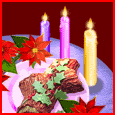|
Yule
Log - Past and Present
While
most people have heard of the Yule Log, few people realize that
its tradition can be traced back to the days of the pagan
Norsemen, or Vikings.
To
celebrate their belief in the powers of the gods, the Norsemen
held festivals. The father of the Gods was Odin or Thor,
commonly called the Yule Father (Yule referred to the sun). The
original Yule Log Ceremony was a festival celebrating the sun
during the winter solstice, which occurs close to the time we
celebrate Christmas today.
Originally,
the Yule Log was burned in honor of the gods and to bring good
luck in the coming year. The log was usually from one of the
largest trees that could be found. It was so massive that to
haul it a team of horses or oxen were needed. After the Norman
invasion of England in 1066, the Yule Log tradition was passed
on to the British and evolved to the tradition that it is today.
After
being cut down, the Yule Log was dragged through the streets.
The log always came from its owners' land or a neighbor's
property, and was never purchased. It was always burned on
Christmas Eve, accompanied by music, fun, and games. It was
customary that each year a piece of the Yule Log was saved and
used to start the fire for the next year's log.
To
help kindle the fire, holly was placed under the log.
Customarily, guests would toss a sprig of holly into the fire to
burn up the troubles of the past year and to keep their houses
safe from burning down in the New Year.
Some
families still persist with this custom on Christmas Eve. An
enormous log of freshly cut wood called the Yule log would be
fetched and carried to the house with great ceremony. On
Christmas Eve, the master of the house would place it on the
hearth, make libations by sprinkling the trunk with oil, salt
and mulled wine and say suitable prayers. In some families, the
young girls of the house lit the log with splinters from the
preceding year which they had carefully tucked away. In other
families, the mother had this privilege. It was said that the
cinders of this log could protect the house from lightning and
the malevolent powers of the devil. Choices about the variety of
wood, the way in which it was lit and the length of time it took
to burn constituted a genuine ritual which could vary from
region to region.
The
custom, which dates back to the ancient times, was known in most
Europeans countries, notably in France and in Italy where the
Yule log was called a ceppo. This tradition persisted in
Quebec as it did in France up until the last quarter of the
XIXth century. Its disappearance coincides with that of great
hearths which were gradually replaced by cast-iron stoves. The
great log was thus replaced by a smaller one, often embellished
with candles and greenery, placed in the centre of the table as
a Christmas decoration.
Today,
the Yule log has become a traditional pastry, a delicious cake
roll, smothered in coffee or chocolate-flavoured icing and
decorated with sugared holly leaves and roses.
Other
Anglo-Saxon traditions include celebrating good health in the
New Year by drinking from the wine-and-spice-filled Wassail
bowl; baking Yule dough into figures shaped like people, with
raisins for eyes and noses, to symbolize Christ (these Yule
Dough people are where today's gingerbread men came from);
burning a Yule Candle, which was big enough to burn for the 12
days of Christmas; and hanging a sprig of mistletoe for
fertility and romance.
|